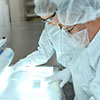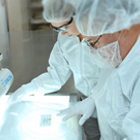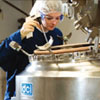Single-use+Temperature+Sensor
Numéro de catalogue:
(PRSI92-192)
Fournisseur:
ProSci Inc.
Description:
Endoglin is a single-pass type I membrane protein which restricted to endothelial cells in all tissues except bone marrow. Endoglin as major glycoprotein of vascular endothelium, it has been found on endothelial cells, activated macrophages, fibroblasts, and smooth muscle cells. Furthermore, Homodimer forms a heteromeric complex with the signalling receptors for transforming growth factor-beta: TGFBR1 and/or TGFBR2. It may have an important role in the binding of endothelial cells to integrins and/or other RGD receptors. Defects in ENG are the cause of hereditary hemorrhagic telangiectasia type 1 (HHT1), which is an autosomal dominant multisystemic vascular dysplasia, characterised by recurrent epistaxis, muco-cutaneous telangiectases, gastro-intestinal hemorrhage, and pulmonary (PAVM), cerebral (CAVM) and hepatic arteriovenous malformations.
UOM:
1 * 50 µG
Numéro de catalogue:
(PRSI31-055)
Fournisseur:
ProSci Inc.
Description:
CXCL14 belongs to the cytokine family which encode secreted proteins involved in immunoregulatory and inflammatory processes. The protein encoded by this gene is structurally related to the CXC (Cys-X-Cys) subfamily of cytokines. Members of this subfamily are characterized by two cysteines separated by a single amino acid. This cytokine displays chemotactic activity for monocytes but not for lymphocytes, dendritic cells, neutrophils or macrophages. It has been implicated that this cytokine is involved in the homeostasis of monocyte-derived macrophages rather than in inflammation.
UOM:
1 * 1 EA
Numéro de catalogue:
(LABS4701290)
Fournisseur:
Thermo Fisher Scientific
Description:
Pour plus d’informations sur Finnpipette™ F3, rendez-vous sur la page principale du produit : https://uk.vwr.com/store/catalog/product.jsp?product_id=2319484
UOM:
1 * 1 ST
Numéro de catalogue:
(PRSI33-198)
Fournisseur:
ProSci Inc.
Description:
Retinol binding protein a single-chain glycoprotein belonging to the superfamily of hydrophobic molecule transporter proteins, which is responsible for transport of retinol (vitamin A1) from the liver to peripheral target tissues, like the eye, where it mediates the cellular uptake. RBP1 is synthesised by hepatic parenchymal cells where it becomes bound to its ligand retinol and is then released into the circulation, where it binds further to the protein transthyretin, to form a transporting complex, which is big enough not to be lost by filtration through the kidney glomeruli. It is detected in nearly all tissues with higher expression in adult ovary, pancreas, pituitary gland, adrenal gland, and fetal liver.
UOM:
1 * 1 EA
New Product
Numéro de catalogue:
(PRSI91-236)
Fournisseur:
ProSci Inc.
Description:
Heat-Responsive Protein 12 (HRSP12) is an endoribonuclease that belongs to the Rut family. HRSP12 is found mainly in the human adult kidney and liver and is responsible for inhibiting protein translation by cleaving mRNA. HRSP12 only cleaves phosphodiester bonds in single-stranded RNA and inhibits cell-free protein synthesis. The levels of both mRNA and protein are markedly reduced in heptatocellular tumors and in human hepatoma cell lines compared with normal liver tissues. Moreover the levels of HRSP12 are different depending on the grade of the tumor. This had led to the suggestion that HRSP12 may be an important biomarker for heptatic carcinoma.
UOM:
1 * 50 µG
Fournisseur:
WTW ONLINE
Description:
Exchange membrane heads for DO sensors TriOxmatic® 600, 690, 700, 700 IN, Pour: TriOxmatic®, Sonde à oxygène dissous
Numéro de catalogue:
(PRSI91-773)
Fournisseur:
ProSci Inc.
Description:
Bone Marrow Stromal Antigen 2 (BST2) is a single-pass type II membrane protein that belongs to the tetherin family. BST2 is predominantly expressed in the liver, lung, heart and placenta. BST2 is involved in the sorting of secreted proteins. BST2 is a human cellular protein which inhibits retrovirus infection by preventing the diffusion of virus particles after budding from infected cells. BST2 is initially discovered as an inhibitor to HIV-1 infection in the absence of Vpu, it has also been shown to inhibit the release of other viruses such as retroviruses, filoviruses, arenaviruses, and herpes viruses. BST2 may play a role in B-cell activation in rheumatoid arthritis.
UOM:
1 * 50 µG
Numéro de catalogue:
(PRSI92-659)
Fournisseur:
ProSci Inc.
Description:
Trem-like transcript 2 protein (TLT2), also known as Triggering receptor expressed on myeloid cells-like protein 2, TLT2 and C6orf76, is single-pass type I membrane protein. TREML2 contains one Ig-like V-type domain, which can be induced in CD4 T-cell by concanavalin-A. As a cell surface receptor, TREML2 may play a role in the innate and adaptive immune response. TREML2 also acts as a counter-receptor for CD276 and interaction with CD276 on T-cells enhances T-cell activation. It has shown that TREML2 may be involved in the innate immune response based on its expression profile and the fact that it is up-regulated in response to inflammation.
UOM:
1 * 50 µG
Numéro de catalogue:
(PRSI38-204)
Fournisseur:
ProSci Inc.
Description:
Interleukin 2 (IL2) is a secreted cytokine that is important for the proliferation of T and B lymphocytes. The receptor of this cytokine is a heterotrimeric protein complex whose gamma chain is also shared by interleukin 4 (IL4) and interleukin 7 (IL7). The expression of this gene in mature thymocytes is monoallelic, which represents an unusual regulatory mode for controlling the precise expression of a single gene. The targeted disruption of a similar gene in mice leads to ulcerative colitis like disease, which suggests an essential role of this gene in the immune response to antigenic stimuli. IL2 has been shown to have antitumor effects in some studies. This is probably mediated by cytotoxic effector cells.
UOM:
1 * 1 EA
Numéro de catalogue:
(PRSI6875)
Fournisseur:
ProSci Inc.
Description:
PTPRD Antibody: PTPRD (Protein tyrosine phosphatase receptor type D) is a member of the protein tyrosine phosphatase (PTP) family that plays diverse roles during development including cell growth, differentiation, mitotic cycle and oncogenic transformation. PTPRD contains an extracellular region, a single transmembrane segment and two tandem intracytoplasmic catalytic domains. The extracellular region of PTPRD is composed of three Ig-like and eight fibronectin type III-like domains (1,3). PTPRD interacts with PPFIA1-3 and is a tumor suppressor on chromosome 9p that is involved in the development of glioblastoma multiforme (GBMs) and multiple human cancers.
UOM:
1 * 1 EA
Numéro de catalogue:
(PRSI91-829)
Fournisseur:
ProSci Inc.
Description:
Interleukin-10 receptor subunit beta(IL10RB), also known as Cytokine receptor class-II member 4,Cytokine receptor family 2 member 4,Interleukin-10 receptor subunit 2, belongs to the type II cytokine receptor family. IL10RB is a single- pass type I membrane protein and contains two fibronectin type-III domains. It is an accessory chain which is essential for the active interleukin 10 receptor complex. Coexpression of IL10RB and IL10RA proteins has been shown to be required for IL10-induced signal transduction. Defects in IL10RB are the cause of inflammatory bowel disease type 25 (IBD25) which is a chronic, relapsing inflammation of the gastrointestinal tract with a complex etiology.
UOM:
1 * 50 µG
Numéro de catalogue:
(PRSI30-374)
Fournisseur:
ProSci Inc.
Description:
ATP5B is a subunit of mitochondrial ATP synthase. Mitochondrial ATP synthase catalyzes ATP synthesis, utilizing an electrochemical gradient of protons across the inner membrane during oxidative phosphorylation. ATP synthase is composed of two linked multi-subunit complexes: the soluble catalytic core, F1, and the membrane-spanning component, Fo, comprising the proton channel. The catalytic portion of mitochondrial ATP synthase consists of 5 different subunits (alpha, beta, gamma, delta, and epsilon) assembled with a stoichiometry of 3 alpha, 3 beta, and a single representative of the other 3. The proton channel consists of three main subunits (a, b, c). ATP5B is the beta subunit of the catalytic core.This gene encodes a subunit of mitochondrial ATP synthase. Mitochondrial ATP synthase catalyzes ATP synthesis, utilizing an electrochemical gradient of protons across the inner membrane during oxidative phosphorylation. ATP synthase is composed of two linked multi-subunit complexes: the soluble catalytic core, F1, and the membrane-spanning component, Fo, comprising the proton channel. The catalytic portion of mitochondrial ATP synthase consists of 5 different subunits (alpha, beta, gamma, delta, and epsilon) assembled with a stoichiometry of 3 alpha, 3 beta, and a single representative of the other 3. The proton channel consists of three main subunits (a, b, c). This gene encodes the beta subunit of the catalytic core. Publication Note: This RefSeq record includes a subset of the publications that are available for this gene. Please see the Entrez Gene record to access additional publications.
UOM:
1 * 1 EA
Numéro de catalogue:
(PRSI91-812)
Fournisseur:
ProSci Inc.
Description:
Protein jagged-1 I, also known as Jagged-1, JAGL1, HJ1, JAG1 and CD339, is a single-pass type I membrane protein. JAG1 contains one DSL domain and sixteen EGF-like domain. JAG1 acts as a ligand for multiple Notch receptors and is involved in the mediation of Notch signaling. JAG1 may participate in early and late stages of mammalian cardiovascular development, JAG1 inhibits myoblast differentiation and enhances fibroblast growth factor-induced angiogenesis. Defects in JAG1 are the cause of Alagille syndrome type 1, which is autosomal dominant multisystem disorder defined clinically by hepatic bile duct paucity and cholestasis in association with cardiac, skeletal, and ophthalmologic manifestations.
UOM:
1 * 50 µG
Numéro de catalogue:
(PRSI91-520)
Fournisseur:
ProSci Inc.
Description:
Carcinoembryonic Antigen-Related Cell Adhesion Molecule 8 (CEACAM8) is a single chain, GPI-anchored, highly glycosylated protein which belongs to the immunoglobulin superfamily and the carcinoembryonic antigen(CEA) family. CEACAM8 is expressed by neutrophils and eosinophils, and serves as a binding partner for CEACAM-6 and Galectin-3. It contains two Ig-like C2-type (immunoglobulin-like) domains and one Ig-like V-type (immunoglobulin-like) domain. Mature human CEACAM8 is a 287 amino acid GPI-linked glycoprotein. CEACAM family members are a set of widely expressed proteins involved in several biological functions, including cell adhesion, migration, signal transduction, and the regulation of gene expression. Abnormal overexpression and downregulation of some CEACAMs have been described in tumor cells.
UOM:
1 * 50 µG
Numéro de catalogue:
(PRSI26-294)
Fournisseur:
ProSci Inc.
Description:
ATP5F1 is a subunit of mitochondrial ATP synthase. Mitochondrial ATP synthase catalyzes ATP synthesis, utilizing an electrochemical gradient of protons across the inner membrane during oxidative phosphorylation. ATP synthase is composed of two linked multi-subunit complexes: the soluble catalytic core, F1, and the membrane-spanning component, Fo, comprising the proton channel. The catalytic portion of mitochondrial ATP synthase consists of 5 different subunits (alpha, beta, gamma, delta, and epsilon) assembled with a stoichiometry of 3 alpha, 3 beta, and a single representative of the other 3. The proton channel seems to have nine subunits (a, b, c, d, e, f, g, F6 and 8). This gene encodes the b subunit of the proton channel.This gene encodes a subunit of mitochondrial ATP synthase. Mitochondrial ATP synthase catalyzes ATP synthesis, utilizing an electrochemical gradient of protons across the inner membrane during oxidative phosphorylation. ATP synthase is composed of two linked multi-subunit complexes: the soluble catalytic core, F1, and the membrane-spanning component, Fo, comprising the proton channel. The catalytic portion of mitochondrial ATP synthase consists of 5 different subunits (alpha, beta, gamma, delta, and epsilon) assembled with a stoichiometry of 3 alpha, 3 beta, and a single representative of the other 3. The proton channel seems to have nine subunits (a, b, c, d, e, f, g, F6 and 8). This gene encodes the b subunit of the proton channel.
UOM:
1 * 50 µG
Numéro de catalogue:
(PRSI33-652)
Fournisseur:
ProSci Inc.
Description:
This antibody recognises an epitope encoded by exon v9 on the variant portion of human CD44. The CD44 molecule belongs to a family of cellular adhesion molecules found on a wide range of normal and malignant cells in epithelial, mesothelial and hemopoiesis tissues. CD44 is a single gene with 20 exons, of which 10 are normally expressed to encode the basic CD44 (H-CAM) molecule. The additional 10 exons (v1 to v10) are only expressed by alternative splicing of the nuclear RNA. The expression of specific cell adhesion molecule CD44 splice variants has been reported to be associated with metastasis in certain human malignancies.
UOM:
1 * 1 EA
New Product
Appel de prix
Le stock de cet article est limité mais peut être disponible dans un entrepôt proche de vous. Merci de vous assurer que vous êtes connecté sur le site afin que le stock disponible soit affiché. Si l'
Le stock de cet article est limité mais peut être disponible dans un entrepôt proche de vous. Merci de vous assurer que vous êtes connecté sur le site afin que le stock disponible soit affiché. Si l'
Ces articles ne peuvent être ajoutés au Panier. Veuillez contacter votre service client ou envoyer un e-mail à vwr.be@vwr.com
Une documentation supplémentaire peut être nécessaire pour l'achat de cet article. Un représentant de VWR vous contactera si nécessaire.
Ce produit a été bloqué par votre organisation. Contacter votre service d'achat pour plus d'informations.
Le produit original n'est plus disponible. Le remplacement représenté est disponible
Les produits marqués de ce symbole ne seront bientôt plus disponibles - vente jusqu'à épuisement de stock. Des alternatives peuvent être disponibles en recherchant le code article VWR indiqué ci-dessus. Si vous avez besoin d'une assistance supplémentaire, veuillez contacter notre Service Clientèle au 016 385 011.
|
|||||||||
















































